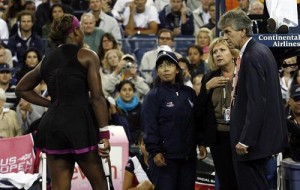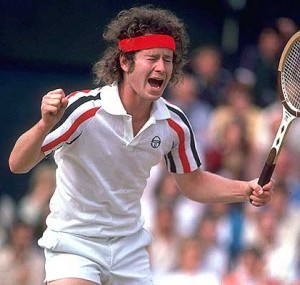The Serena Williams Tirade: Fined, But Not Forgiven
Serena Williams was fined a record $82,500 for her tirade at the 2009 U.S. Open when she allegedly threatened a lineswoman who called a foot fault against her.
In fact, using very colorful language, Ms. Williams insisted that she would force-feed the tiny lineswoman a tennis ball for daring to make her tenuous foot fault call at such a critical moment in the match—all the while pointing her racket, jabbing it like a sword toward the diminutive lineslady.
The younger Williams sister was serving to retain her U.S. Open crown during a hard-fought prime-time semifinal contest.
The foot fault caused Williams to double-fault, and the subsequent penalty gave the match to Kim Clijsters, who stood by watching it all unfold like a deer in the headlights.
The Belgian, recently returned to tennis, won the match without firing the final shot.
Williams’ fine is categorized as a “major” offense, taking place as it did at a Grand Slam event. Plus Williams is on probation for the next two years.

The outburst at the U.S. Open has resulted in two years of probation for Williams.
If the younger Williams sister commits such a heinous act again at any of the four Grand Slam events, she’ll be barred from competition at a future U.S. Open.
Everyone will be watching Williams like a hawk for further egregious conduct. You can bet that more empty rhetoric on this topic will be forthcoming as commentators scramble to fill air time during her future matches.
Grand Slam Administrator Bill Babcock said a “major offense” under Grand Slam rules is “any conduct that is determined to be the ‘major offense’ of ‘aggravated behavior’ or ‘conduct detrimental to the game.'”
There is no specific definition of what sort of actions constitute a “major offense.” It sounds as if they are making up the rules as they go, with a kind of circular reasoning we often encounter at biased country clubs or movie studios.
Williams had already paid an on-site fine of $10,000 to the USTA.
Undoubtedly tennis authorities had to do something big, since this infraction took place at the U.S. Open during the televised semifinals. It seemed logical to lean heavily on financial assessment.
Williams made over $6 million in 2009, so the $85,000 fine seemed like bubble-gum money in proportion.
Certainly those assigned to take action against the World No. 1 tennis player were also those whose organizations would be severely hurt if the “Grand Slam Committee” banned the popular and powerful Williams from competition.
These tennis authorities need Williams playing in the Australian Open because she is the No. 1-ranked player. To bar her from competition would lessen the tournament the ITF is empowered to oversee. Frankly, it might hurt their purse strings if they denied her entrance into the Aussie Open.
So what does it all mean? Why all the black ink and hysteria over this incident? It is not as though we have not witnessed tirades before…think John McEnroe. Think Ilie Nastase and Jimmy Connors. They were crude, rude, and often turned the air blue with expletives.

While Williams was chastised for her outburst, the constant tantrums and berating of officials perpetrated by John McEnroe are now remembered with fondness.
But Williams is a woman who apparently uttered the dreaded “F” word in public. Bring out the smelling salts! This is tennis! She is a role model! She is a woman!
Evidently Williams felt free to vent her obvious anger and frustration regardless of the consequences…so much so that we suspect she anticipated none.
Was this typical behavior on the part of the younger Williams sister? No. It was an aberration from her usual on-court demeanor. Both Williams sisters normally accept all calls without comment or incident.
But it did highlight Serena Williams’ increasingly aggressive behavior and her highly publicized inability to admit her mistakes with the proper degree of regret or acceptable temperament and attitude.
She wasn’t sorry enough…nor did she observe the proper level of remorse for her actions.
But, saints alive, we live in a society of such high moral fiber that people and the press remain outraged by Williams’ bullying behavior. Mary Carillo espoused censure.
Never mind that today Carillo and Co. treat John McEnroe’s tirades as “the good old days of tennis” and Mr. McEnroe’s behavior has been condoned as cute and cuddly.
These high-minded harbingers of purity remain morally incensed by Williams’ breach of good conduct. They feared for the life of the tiny and terrified lineswoman. Where was justice when it was called for in this situation?
Justice remained in the counting house…counting out its money. That is why it took the ITF two months of “investigation” to come up with that perfect punishment. Just enough for the public to say “ouch!”
But not enough for Williams to balk and walk away. When the governing body of tennis has so little impact that it cannot separate its disciplinary practices from its financial needs, this is the result.
In this case, Williams is treated as an important cash cow for the women’s game, whereas poor Yanina Wickmayer is not.
Wickmayer, from Belgium and currently ranked No. 18, has been suspended for a year from all tournaments—not because she tested positive for any illegal drug, but because she did not report where she would be to tennis authorities.
This is the consequence when individual players become more important than the sport itself. They have created an unequal playing field where some rise above the policies and others are struck down often without review or appeal…or even logic.
When the Australian Open begins in 2010, Williams will be seeded No. 1 with all the advantages still in her corner while Wickmayer will be left home in Belgium, watching the outcome on television as she sits out her year of suspension.
Whose behavior got what it deserved? None in this analysis.
What have we learned besides the fact that: 1. Linespeople need to be replaced by available technology. Who would care if McEnroe, Connors, or Williams went off on a machine; then again, though, why would they? 2. Rules need to be specific and applied uniformly to every player regardless of his or her rank or the financial impact on the sport.
That is asking a lot when a sport’s official governing body oversees players whose appearance fills the governing bodies coffers. It just doesn’t work—never has, never will.
Regardless of your opinion concerning the actions of Serena Williams at the semifinals of the 2009 U.S. Open, the action taken by the ITF smacks of favoritism and impotence.
